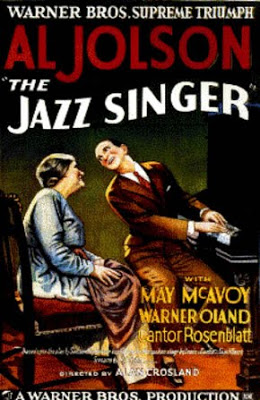 "There are lots of jazz singers, but you have a tear in your voice." So is the common praise for the voice of a son of a Jewish cantor who defies his home and hertitage to seek out a career as a jazz singer. His big chance finally arrives with the help of a pretty girl, but trouble at home puts him in conflict with himself. Will the ideal of following your dreams be his guiding light, or will the importance of family and home win out?
"There are lots of jazz singers, but you have a tear in your voice." So is the common praise for the voice of a son of a Jewish cantor who defies his home and hertitage to seek out a career as a jazz singer. His big chance finally arrives with the help of a pretty girl, but trouble at home puts him in conflict with himself. Will the ideal of following your dreams be his guiding light, or will the importance of family and home win out?It is a plot that is unremittedly hammy and smaltzy, outdated even when the film was being made. Critics at the New York Tribune called the film "a pleasantly sentimental orgy dealing with a struggle between religion and art...." Yet this movie makes the grade as #90 on the American Film Institute's top 100 films for one very important reason- hearing that voice with a tear. Sound had come to film with 1927's The Jazz Singer.
The Jazz Singer was not, as commonly believed, the first film with sound. Several shorts with sound had been premeired before this, but it was the first commercially sucessful sound film, and the first feature length film to use sound. There was one other way it broke presidence too- and not entirely on purpose either! Except for the musical numbers and the symphonic soundtrack, the film is silent, utilizing titlecards. A technical oddity was all that made this the first film where actors talked. Though people from Edison on had been trying to put sychronized sound to moving pictures, the idea of having dialogue had never been the purpose. "Who would want to hear actors talk?" Sam Warner, the man behind the studio's push toward sound, famously asked. Recorded on Vitaphone, The Jazz Singer took an unprecedented nine reels of film. Not because its so long- it runs a little over an hour- but because Vitaphone, the process then used to record sound, was so expensive only the music numbers got it. They had to switch back to the cheaper, silent reels when no one was singing. However, twice talking sneaks in the middle of a Vitaphone reel. As these scenes were played on opening night, people described a sense of excitment like electricity rippling shockwaves through the audience when they heard those voices talk. "Wait a minute! Wait a minute! You ain't heard nothin' yet!" Three simple sentences to change the face of film forever. Al Joleson couldn't be more right; they hadn't heard anything yet. Through it would take several years to change things over to the expensive, sound-producing equipment both in Hollywood and in movie theaters around the country, sound was to become the way of the movie-making world.
It was not just the talking people went to see though. In The Jazz Singer, technilogical advancement, and the perfect star came together when Al Joleson, The World's Greatest Entertianer, crooned on the silver screen. In fact, corny as the script is, it is based on Al Joleson's life. He nearly wasn't given a part to play though. The Jazz Singer had started out life as a book and was made into a Broadway play when the Warner brothers snatched up the movie rights, intending to make a silent picture. Along with the rights they had to sign the (musicless) play's main actor. When they made the decision to switch to sound and add in music, that actor wanted more money, so it gave them the excuse to give him the boot! Al Joleson gives his first acting performance in this film, and if it sometimes shows, that hardly matters. He got his title of World's Greatest for a reason: music.
Personally, I found the movie entertianing. The plot, as I said, is sentimental and somewhat hokey, but it draws you in just the same! I felt for the mother everytime she was on screen; you could just feel the familial love. The music is what you really stay for. Not every song is going to thrill modern audiences who, use to the more daring jazz of the thirties and forties, may find the "sweet" jazz/ragtime beats a little bland. However, Al Joleson's "Toot, Toot, Tootsie" and "Blue Skies" are sure to be winners, remaining classics even today! The whistling might be my favorite part.

Modern viewers might also be warned that this movie does have the main character, Jack (Al Joleson), perform in blackface. Some might argue that the blackface is used to further the story; the Jew confronts his place in American Culture while dressed as another outsider. Some might say that unlike some other blackface performers, Al Joleson did not do stereotypical impressions, but merely used the makeup to better highlight his eyes, lips and hands (the most important parts to see when a singer has the stage). Some might point out that African Americans of the time also used blackface, and that African American papers praised the film and Joleson. But the fact of the matter is simple. It was a different time whose views should not be argued away nor ignored. While I feel this new century has the right attitude towards racist depictions, it should be acknowledged that each time has its own morals, values antis own issues, and that trying to condemn it based on that would deprive us of a historical moment in film and art. It was at that moment cinema audiences realized they hadn't heard nothin' yet.

nice review <3
Reply Delete